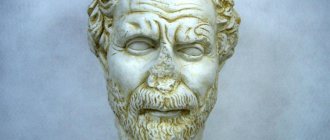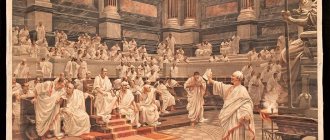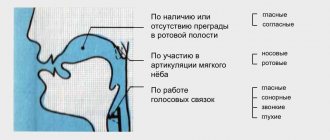It is believed that ancient rhetoric appeared after the sunny city of Syracuse, in Sicily, in 465 BC. e. Tyranny was overthrown and democratic rule was established, under which everyone can and should participate in governing the state - and for this one must be able to speak competently and convincingly. The first sophists, Tisias and his student Corax, wrote the first textbooks on rhetoric so that every citizen could quickly and effectively master the skills of public speaking.
The further development of rhetoric is associated with the spread of the intellectual movement of the Sophists, the most significant representatives of which were Gorgias, Protagoras, Hippias, Prodicus, Antiphon, Thrasymachus. These traveling encyclopedist teachers around the same time made rhetoric the basis of their educational program and taught their knowledge to the golden youth of the Greek city-states for a lot of money, preferring to tour in Athens, the richest Greek city at that time. Thus, one lecture by Prodicus cost 50 drachmas, and a full course of Protagoras cost 10 thousand drachmas. For comparison: the daily salary of an experienced worker or sailor on a ship was 1 drachma, a heavily armed hoplite warrior received 2 drachmas a day, an ox at that time cost 50–100 drachmas, the fine for dishonoring a free woman was 100 drachmas, and a slave could be bought for as many.
It should be noted that the word “rhetoric” itself was not used by sophists, philosophers, or other writers of that time. It comes from the Greek word ῥῆμα (rema), meaning "speech", "word", "saying" or "verb" in the grammatical sense. In 395 BC. e., after the educational boom of sophistry, the philosopher Plato writes the dialogue “Gorgias”, named after the famous sophist and dedicated to rhetoric, where the phrase ῥητορική τέχνη - rhetorical art (the word τέχνη, or techne, from which the word “technology” comes) is first introduced in antiquity, any skill in general was designated - be it culinary art, the art of a helmsman, a doctor, etc.). After this, with the light hand of Plato, the word “rhetor” (ῥητῆρ) begins to denote a politician professionally trained in persuasive speeches: there were no politicians in our understanding in Greece, and the interests of the people and the state were in the People’s Assembly (ekklesia) and the State Council (bule) represented by rhetoricians, or orators (you just need to remember that the last word is not Greek, but Latin, it appeared much later). Such a rhetorician-politician could be any free citizen who had reached about thirty years of age - by this time the young Greek most often already had time to start a family and a household, take part in wars, morally “grow up” and, therefore, become more deeply integrated into the social communication of the polis, basically which was primarily the spoken word.
Although Plato introduced the word “rhetoric” into intellectual and political circulation, he despised rhetoric itself with every fiber of his soul, because he believed that, not knowing the essence of things, it tells people not what really is, but exclusively what they are want to hear, misleads them and leads them to destruction.
Plato had his reasons for not liking rhetoric: rhetorical practice comes from democracy, and democracy, as we know, destroyed Socrates, his favorite teacher.
However, Plato's favorite student Aristotle, to whom truth was dearer than Plato's friend, not only developed rhetorical theory, but raised it to unprecedented heights. Aristotle’s famous work is called “Rhetoric,” and in our pocketbooks it is most often published together with his “Poetics,” dedicated to the theory of art.
With Plato (or rather, even with Socrates), the centuries-old dramatic confrontation between two fundamental cultural discourses - rhetorical and philosophical - begins, and since, as Whitehead wrote, all subsequent philosophy is only a marginal commentary on Plato, then, as you might guess, this rivalry continues until now: some philosophers and even entire eras affirm the primacy of the rhetorical principle, others - the philosophical.
Isocrates, a contemporary of Plato and a student of Gorgias and Tisias, followed the path of further improvement of rhetorical practice. Around the same time that Plato at the Academy built an educational program on the basis of his philosophy, Isocrates at his school made rhetoric the basis of teaching. However, this was not just a school of oratory, if only because Isocrates himself was never an orator; he naturally had a very quiet voice and was terrified of speaking in front of a large audience. He was what we would now call a speechwriter, and the Greeks called such people “logographers,” that is, speech writers, and through his speeches Isocrates not only taught students to speak beautifully, but tried to instill in them moral qualities so that future politicians would not only eloquent, but also virtuous.
Isocrates, unlike his colleague and competitor Plato, understood rhetoric quite neutrally: for him it is neither useful nor harmful, and responsibility for its benefits or abuses falls on the one who practices, and not on the one who teaches. Isocrates said:
“...Things by their nature do us neither good nor harm, but the way people use and apply [things] is the cause of everything that befalls us.”
By the way, Aristotle understood rhetoric in a similar vein, who, before enrolling in studies with Plato, studied rhetoric for some time with Isocrates.
This time is the 5th and 4th centuries BC. e., is considered the golden age of oratory: it was then that the masters created who later entered the great canon of ten Attic orators. Of course, we won’t be able to talk about them all, so we’ll simply list them by name: Antiphon, Andocides, Lysias, Isocrates, Iseus, Aeschines, Lycurgus, Demosthenes, Hyperides, Dinarchus.
The Age of Hellenism: rhetoric as a school discipline
In 338 BC. e. A tragic event for Greek independence occurred - the Battle of Chaeronea was lost, and Greece fell under the rule of first King Philip of Macedon, then his son Alexander, and after the death of the latter - his diadochi (successors). The role of the people's assembly, the main arena of eloquence, is rapidly declining at this time due to the lack of political independence, and, consequently, the quantity and quality of political speeches is declining. The Hellenistic era begins.
In all corners of Alexander’s vast and fragile empire, Greek culture began to spread, which, combining with the local cultural characteristics of a variety of countries, formed an absolutely unimaginable and hitherto unprecedented cultural fusion. Among the linguistic changes was the emergence of the pan-Greek dialect Koine, which first became the common dialect in the armies of Alexander the Great, and eventually became the diplomatic and literary language of the entire Mediterranean. With the spread of the Greek language, the spread of Greek education begins, the most important element of which is the so-called paideia - the education of social, moral and political virtues. The division of paideia, common to the global world at that time, simplified communication and made it more effective. Subjects could count on understanding from the ruler (most often a Greek) if they shared the same values as him. Something like the unification of education according to the Greek model is happening. In order to successfully transmit Greek culture, rhetoric and grammar schools begin to open throughout the Mediterranean. Grammarians taught Greek language and literature, rhetoricians taught the art of speech.
Almost no recorded speeches or rhetorical works survive from the Hellenistic era. This, however, does not mean that rhetorical issues were not being developed at that time.
Thus, Theophrastus, a student of Aristotle, as ancient authors report, wrote about twenty essays on rhetorical topics, which, alas, were all swallowed up by merciless time. It is difficult to say to what extent he followed the theories of his teacher: Quintilian, who will be discussed below, reports that Theophrastus put forward positions that differed from the ideas of Aristotle. One way or another, most often ancient authors referred to his essay “On Style.”
The unsystematized education that existed in Athens during the classical period (V-IV centuries BC) was streamlined in the Hellenistic era and became the so-called encyclopedic, or general education, which included rhetoric (encyclopedia from ἐγκύκλιος παιδεία - “circular education "). Such education occupied a middle stage between primary (learning to read and write) and something like higher education (study of philosophy). His circle included grammar, geometry, astronomy, literature, music, rhetoric and dialectics. These are the famous seven liberal arts (septem artes liberales), which began to be practiced sporadically by the Sophists and which found their final form already in Rome, and then in the form of trivia and quadrivium they passed into the system of medieval university education.
Most often, these disciplines were taught by one or two teachers, and only rich people in big cities could afford to hire a separate rhetoric teacher, geometry teacher, etc.
3conclusion
The orators and theorists of eloquence of Ancient Rome were able to penetrate the secrets of the word, expand the boundaries of its knowledge, put forward theoretical and practical principles of oratory as an art, based on their own rich experience and on the analysis of numerous brilliant speeches of famous speakers. Their works contain such an interesting and deep analysis of the art of persuasion that many centuries later, in our days, propaganda specialists study and find there ideas that were considered an achievement only of modern times.
Roman Republic: the great Cicero and rhetoric as the pinnacle of sciences
The Roman historian Suetonius, in his essay “On Grammarians and Rhetorians,” points out that at first rhetoric and grammar had difficulty making their way in Rome: special decrees of the Senate from 161 and 92 BC prohibited their study. e. The first decree expelled visiting Greek philosophers and rhetoricians, the second - Roman ones. And here is the text of the edict itself:
“It has come to our attention that there are people who have introduced a new kind of science, young people gather in their schools, they have adopted the name of Latin rhetoricians, and there young people idle all day long. Our ancestors established what children should be taught and what schools they should go to; innovations created contrary to the customs and morals of their ancestors seem incorrect and undesirable. Therefore, we consider it necessary to express our opinion for those who maintain schools, and for those who are accustomed to attending them, that we do not want this.”
This phobia is primarily explained by social changes in Roman life. The aristocratic Senate was losing political influence, and the class of horsemen and plebeians entered the arena of political struggle. They had to prove their case by speaking in meetings, but they had no experience in making speeches. For this reason, they began to actively study Greek eloquence. The first schools of rhetoricians appeared, where at first the Greeks taught, and then, a generation later, the Romans themselves.
The outstanding orator Cicero, heir to the tradition coming from Isocrates, who tried to reconcile rhetoric and philosophy, also belongs to this generation. He studied philosophy from the Epicurean Phaedrus, the Stoic Diodorus, and from the head of the then Platonic Academy, Philo. From the latter he also studied dialectics - the art of argument and argumentation. A passion for philosophy and especially Stoicism led Cicero to the idea that an orator should also be a philosopher.
By the time of Cicero, rhetorical theory had become so advanced that it had become self-contained, separating itself from other aspects of human knowledge.
According to the behests of Gorgias, it became possible to talk about anything, even without knowing the subject. This was acceptable in the Hellenistic monarchy, where rhetoric served mainly to delight the ear with speeches of praise, but Rome, during the crisis of the republic, needed rhetoric connected with real life, it had to again include a political dimension, and not remain a refined school discipline. Cicero makes an attempt to combine rhetoric with both philosophy and realpolitik; three of his dialogues are devoted to this program: “On the Orator”, “Brutus”, “Orator”.
At that time there was a struggle between the Asian (Eastern) and Attic rhetorical styles. Cicero himself, familiar with all these trends, tried to maintain a middle position and therefore adhered to the Rhodian school of rhetoric, which traced itself to Isocrates - not as modest in terms of style as, for example, Lysias, but also not as cloying as Gorgias. He looks for a model of eloquence in Greek antiquities, speaking words of praise, including to the sophists, and complaining that the enmity between philosophy and rhetoric begins with Socrates. At the same time, he believes that Socrates was far superior in eloquence to his rivals, the Sophists.
Cicero's rhetoric is closely connected with his politics: a skeptic, he could not help but understand that any point of view has a right to exist. But he also understood that to make a point of view “true” means to present it as convincingly as possible, that is, to demonstrate oratorical abilities. For Cicero, rhetoric is the pinnacle of science precisely because the truths of all other sciences ultimately pass through its discourse (in the world of skepticism, the truths of science are relative, and the truths of eloquence are absolute, since they are convincing). At the same time, the speaker must be comprehensively developed, know poets, philosophy, history and generally have encyclopedic knowledge, not excluding acting skills. “It is impossible,” says Cicero, “to be a commendable orator in all respects without studying all the most important subjects and sciences,” and, therefore, “the orator must have the wit of a dialectician, the thoughts of a philosopher, the words of almost a poet, the memory of a lawyer, the voice of a tragedian, acting like the best actors. That is why in the human race nothing comes across as rarely as a perfect orator.”
Rhetoric and oratory
Oratory is the art of public speaking for the purpose of persuasion. This is a harmonious combination of rhetoric, acting techniques and psychological techniques. Even in ancient times, the vocation of an orator was considered to teach and instruct listeners.
For ancient Rome, Aristotle remained the highest authority in the field of rhetoric, however, the Romans contributed a lot of valuable and noteworthy things to this science and especially to the practice of oratory. First of all, their merit lies in the development of techniques for composing speeches, analyzing arguments, arguments and improving the style and beauty of speech.
The efforts of ancient Roman orators were concentrated around the problems of political struggle in the Senate, at popular assemblies, as well as judicial proceedings. Therefore, they were little interested in theoretical issues of argumentation and rhetoric in general. The only exception to this was, perhaps, the outstanding orator of ancient Rome, Marcus Julius Cicero, who invariably emphasized in his writings the need to combine eloquence with persuasiveness, rhetoric with philosophy. True, the philosophical views of Cicero himself cannot be called consistent and monistic, since he tried to combine in his worldview the views of such incompatible ancient schools as the Stoics (logic, physics and ethics), the Peripatetics (the study of language in motion) and the Academicians. In rhetoric, Cicero tried to combine, on the one hand, the philosophical principles of Plato and Aristotle, and on the other, purely practical techniques and recommendations coming from Socrates. However, his main attention is not paid to philosophical principles. He is most interested in the applied side of rhetoric, its skillful use in the Senate, people's assembly, and court.
The Roman Empire: Decline of Style, Praise of the Fly and the Emergence of Love Novels
After the death of Cicero in 43 BC. e. a gradual departure from his rhetorical theory towards greater formalization begins, and with the era of the Principate of Augustus and the Empire, rhetorical schools began to flourish and, at the same time, the style of eloquence deteriorated. The main method of rhetorical teaching in these schools was recitations, speeches on fictitious topics of two types: counterversions - speeches about a fictitious problematic legal case, when there is a contradiction either between laws, or between law and feeling, etc., and suazoria - exhortations and also fictitious speeches addressed to a hesitant person who cannot make a decision. The form of speeches began to prevail over the content, the pursuit of effectiveness overshadowed credibility. It was in this form that the imperial school of rhetoric existed almost until the fall of the Roman Empire in 495 AD. e. Young speakers, leaving school and getting to a real court hearing, turned out to be completely unprepared; their education had nothing to do with real court cases. Accordingly, such a school began to be sharply criticized by those who believed that oratory and language needed to be restored to the splendor of Cicero's time. As a result, something like the motto “back to Cicero” was proclaimed. From all sides (Petronius, both Senecas, Longinus “On the Sublime”) the sophisticated simplicity of the new eloquence and the separation from Ciceronian ideals were criticized. They studied Cicero, of course, but they understood that a return to him in the current conditions was no longer possible, since the republic no longer existed.
So, at the end of the 1st century AD. e., more than a century after the death of Cicero, the famous Roman rhetorician Marcus Fabius Quintilian writes a large text “On the Education of the Orator” - the longest work on rhetoric preserved from Antiquity. He ran a school of rhetoricians with funds allocated by Emperor Vespasian, and was the tutor of his son Domitian. The restoration of Cicero's classics began. Quintilian tries to comprehend the ancient expression of Marcus Porcius Cato the Elder vir bonus dicendi peritus
- “a worthy man is skilled in speeches.” In his opinion, in order for a man to be worthy, he must be taught morality from infancy, and in order for him to be skilled in speeches - from childhood, even before rhetoric, he must be taught grammar, music and in general everything that is possible, and then eloquence according to models the best ancient speeches and, first of all, Cicero.
Cicero himself did not attach much importance to schools and said that he was raised not in a stuffy rhetorician’s closet, but in the air of the Academy, and in his youth he gained experience in the homes of respectable and experienced orators and senators. Quintilian believes that school is the basis of education. For Cicero, the main things in teaching are philosophy, history and law, and theoretical rhetoric is secondary. In Quintilian, out of the twelve books of his huge work, nine are devoted to a scrupulous analysis of rhetorical theory. For Cicero, philosophy lies at the heart of rhetoric, for Quintilian - classical literature, and therefore for Cicero the orator is a thinker, and for Quintilian - a stylist. The orator Cicero should be evaluated by the people, the orator Quintilian is a sophisticated and educated connoisseur of literature. Cicero, looking to the future, sees progress in the art of eloquence; Quintilian sees only decline and a short-lived revival occurring in his own time.
A short time after the death of Quintilian, an amazing cultural phenomenon arose in the Roman Empire - the second sophistry, covering the 2nd–4th centuries AD. e. Like many interesting and original things, this sophistry came from the East, from the cities of Asia Minor - Rhodes, Smyrna, Laodicea. Since the political activity of traditional democratic institutions in this era came to naught, the sphere of activity of itinerant rhetoricians-sophists became primarily epideictic (eulogy) speeches and less often judicial apologies (Apuleius, “Apology, or Speech on Magic”). Speeches were read praising the cities visited, the opening of monuments, and local heroes.
A favorite technique is praise-paradox of some insignificant objects or phenomena - a fly, a mosquito, smoke.
Unlike the first sophistry, the second does not pose cognitive problems; it is far from philosophy, but covers the entire area of intellectual activity. The concept of mimesis, introduced into intellectual circulation by Aristotle, completely changes its meaning. If previously mimesis was understood as the imitation of nature through techne and poeisis (that is, through craft and art), now it means only imitation of the second order, imitation of imitation, discourse about discourse. In the first sophistry, being is the effect of speech or rhetoric, but here there is no being at all, but there is only a palimpsest on which something was written, then erased and written again. First of all, the plots of Athenian history were imitated and stylized in declamatory speeches while preserving the Attic dialect.
One of the “first” second sophists was Polemon from Smyrna and the permanent ambassador of this city, an acquaintance of the emperors Trajan, Hadrian and Antoninus Pius. He wrote a recitation in which the fathers of the two heroes of the Battle of Marathon argue which of their sons deserved greater glory. In his performance, he actively used artistic methods, attracting attention and influencing the listener with the expressiveness of emotions.
Polemon loved rhetoric and speech so much that, as Philostratus writes, when his friends were mourning the dead, he cried out loudly: “Give me the body, and I will recite!”
Polemon's student was Herodes Atticus, a friend of Emperor Hadrian and Antoninus Pius. The latter appointed him teacher to the future emperors Marcus Aurelius and Lucius Verus (co-emperor), and then made him consul in 143. Herodes Atticus became the first Greek to receive such a high position in Rome. His speech has been preserved, encouraging the Spartans to come to the aid of the Thessalians against the Macedonians: Herod imitates Thrasymachus of Chalcedon in it, so skillfully that until the 19th century this speech was considered the work of a Chalcedonian.
A student of Herodes would be Aelius Aristides from Smyrna (2nd century AD), from whom many speeches have come down to us, fifty-five. In his speech “In Praise of Rome,” he praises imperial policies. Aelius Aristides was also a staunch supporter of Atticism and fought for the revival of the Attic dialect in literature. In his speech “Against those who are like dancers” (Κατα των έξορχουμένων), he reminds that the rhetorician must strive for precision and accuracy of style, which is achieved only by imitation of classical Greek writers.
The above writers are, so to speak, pure rhetoricians; they come from the richest families, representatives of the elite. But there was a wave of, let’s say, “philosophizing” rhetoricians-sophists, but there were much fewer of them. One of the prominent representatives of this wave is Dion Chrysostomos (40–115 AD), who combined in himself a wandering orator and a Cynic philosopher. Emperor Domitian sent him into exile because of his participation in a conspiracy, and he went to wander (he got all the way to Scythia), earning a living by daily work and preaching among the poor. Under Nerva and Trajan, he was returned to Rome and again took up public activities. Dion’s favorite oral literary genre was the Cynic diatribe (διατριβή - exercise), that is, a philosophical monologue with ethical content interspersed with dialogue with an imaginary interlocutor.
Dion was a staunch opponent of slavery and admired the simplicity of the ancient Cynics, especially Diogenes of Sinope (yes, the one who lived in a barrel). In Dion's speeches, the idea of true beauty is associated with moral perfection. It is interesting that, like Plato, his beauty is embodied in a youthful appearance. A supporter of autocracy, Dion opposes tyranny, which, in his opinion, destroys beauty and virtue. Discussions about the wonderful poet and philosopher are inseparable from attacks against ancient and new tyrants. What is important to Dion is the ideal of a free citizen, whose words do not diverge from his thoughts, who enlightens citizens without expecting reward.
Nevertheless, the focus of the second sophistry remains exclusively on problems of language and style. As for genre novelty, much attention was paid to school genres - descriptions (ekphrasis) and the epistolary genre (letters). It was from this era that many forged letters have come down to us, supposedly belonging to Themistocles, Socrates, Diogenes and others. Over time, instead of philosophical content, everyday life begins to appear in the letters, which comes from the new Attic comedy and love lyrics. Entire collections of such fictitious letters appear, one of which was compiled, for example, by Philostratus.
The real innovation of that time was the development and development of the Greek love story.
Both in letters and in the novel, rhetoric went beyond the scope of school rhetorical education. From this time, five completely preserved canonical love novels have survived (only scattered papyrus fragments have survived from the 3rd–2nd centuries BC): “Chareus and Callirhoe” by Chariton from Aphrodisias, “The Ephesian Tale” by Xenophon of Ephesus (beginning of the 2nd century), “Leucippe and Clitophon” by Achilles Tatius (late 2nd century), “Daphnis and Chloe” by Longus (2nd century) and “Ethiopica” by Heliodorus of Emesa (3rd–4th centuries).
Almost all novels, with the possible exception of Daphnis and Chloe (they are slaves, the plot is based on the innocence and timidity of the heroes), have the same narrative matrix - a handsome young man and a girl fall in love with each other, then they are separated by fate, separated they endure all kinds of torment and misfortune (captivity from robbers, kidnappings, shipwrecks, sale into slavery, threat of execution, etc.), then after all these ups and downs they meet, recognize each other and find the desired happiness.
These Greek novels are opposed by “The Golden Ass,” written in Latin, a novel by the famous Apuleius (2nd century), one of the most famous writers and rhetoricians of the era, a Platonist philosopher from Madavra (modern Algeria). Apuleius was a man of his time - he received an excellent education, studied in Carthage and Athens, studied philosophy and rhetoric, history, was a poet, and a lawyer. An example of oratory is his apology, written in response to the accusation of practicing magic brought against him. Other prominent representatives of the second sophistry include Flavius Philostratus, Athenaeus, Aulus Gellius, Diogenes Laertius and Libanius.
This marks the end of the era of ancient rhetoric and the beginning of medieval rhetoric, which is based on the struggle between paganism and the new Christian religion, and its main genres will be sermons and theological exhortations, this is largely another story.








